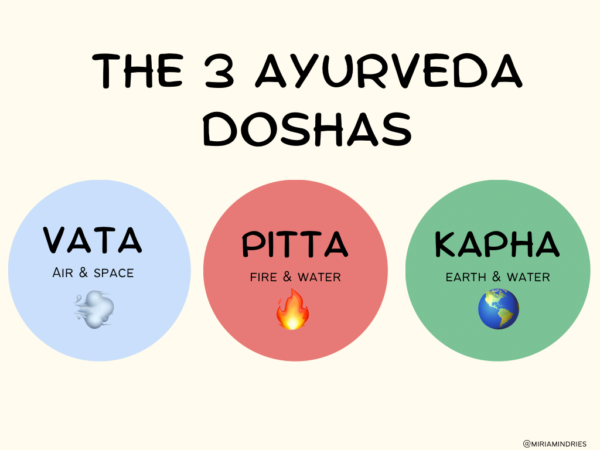Information


Ayurveda is a beautiful life science that resembles a holistic lifestyle of wellness and maintaining health. This is done by understanding our natural cycles, behaviours, tendencies, digestion type and much more. These all come down to the primary Ayurveda dosha of a person. According to Ayurveda, every person has a unique Ayurveda constitution from birth, which is called Prakruti (nature) which remains the same throughout our physical life. There are 3 doshas, Vata, Pitta and Kapha and each one of these is represented by two main universal elements. Although every person has all 3 doshas, one of them is usually more dominant and of higher percentage.
Let’s look at each of the 3 doshas and understand how we can identify our unique Ayurvedic constitution:

Vata dosha is represented by the elements of air and space. To understand everything about Vata, we can simply look at the qualities of the two elements. Air is changeable, dry, quick, cold, rough, whilst space is emptiness. Vata predominant individuals usually have a thin body frame, and in general find it hard to gain weight. Their skin is usually pale and their skin, hair, nails can often become dry easily, especially during the cold seasons and dry cold weather. The Vata digestion patterns are changeable, just as the element of Air, although most of the time if out of balance, constipation can be experienced.
VATA DOSHA PERSONALITY:
Being the social butterflies of the 3 doshas, people who are Vata predominant are usually great communicators and enjoy being around people. They prefer to be surrounded by others and often need external motivation because whilst they have great ideas, and can be very creative, they tend to get bored easily and jump onto the next thing quickly. Vata predominant individuals make friends very easily but can also change/have many different circles of friends.
Vatas are usually good at attention to detail, but they cannot commit easily, or stick to something. They might have great ideas, but often lack the motivation, focus and drive to put this in action. Every moment can be spontaneous for a Vata as they change quickly and can be unpredictable.
WHAT VATAS NEED
Nourishment, social life/company, structure and excitement are all helpful aspects to implement in a Vata lifestyle. Some structure is needed to stick to what they set out to do, but with some space for spontaneity and freedom. Foods that are warm or have heating quality are usually favourable, including warming spices such as Turmeric, basil, fennel, cumin, ginger etc. Raw food can be tricky because it is usually more difficult to digest and for the cold qualities of Vata this would not help. So cooked meals are usually much more suitable for Vatas.
A sleeping schedule/routine is also needed to ensure that a good quality sleep, so that the mind can feel well rested and more calm.

Pitta dosha is represented by the elements of fire and water, although primary fire. In every body, Pitta is responsible for digestion and it’s the agni, or the digestive fire. Some qualities of fire are hot, intense, sharp, reactive, strong, powerful and passionate/fiery by nature. These qualities tend to be dominant in a person with a Pitta predominant dosha. Generally, Pitta predominant individuals have a toned, muscular body or have more muscular definition. They tend to be of moderate weight. Because they have the fire element more predominant than for the other two doshas, Pitta predominant constitution people generally can digest food easier (although not always).
PITTA DOSHA PERSONALITY
In general, Pitta predominant dosha individuals can be very organised and structured, smart, sharp, focused, passionate, loving and certain of what they want. When they are out of balance (Pitta is increased), qualities such as anger, irritability and frustration can take over. Because of their passionate nature, Pittas can be very intense and easily reactive. This also applies to their body, particularly their skin and digestion.
Pitta predominant dosha people have a good sense of humour, yet they are selective with their circle of friends. Because of their organised and structure nature, they tend to give their time to social and romantic relationships that bring some sort of value; they are not phased about small talk or being alone. In general, although they are friendly, they enjoy time alone and prefer to do many things alone because they can focus and get things done, which is part of their character. Competitiveness is another trait of Pittas, which drives them to work a lot of hours.
WHAT PITTAS NEED
Some spontaneous, not necessarily planned adventures might help a Pitta person to try something new and have some fun/to do something just because it is enjoyable, without the need to achieve anything. Because they are so focused most of the time, taking some time away from work and creating a harmonious work/life balance would benefit them. Foods that are cooling will help to kindle their agni, as well as having regular meals, without skipping any of the three main daily meals. Spices such as coriander, mint, parsley, ginger and cinnamon (the last two, both in smaller doses) are suitable for Pitta dosha individuals. Exercises such as slow jogging and Pilates are suitable and asana practices such as Ashtanga Vinyasa and Hatha yoga are favourable for Pittas. In my opinion, at least one weekly session of yin yoga would be favourable for them as this will help them relax and learn to be more gentle and loving with themselves, because they tend to put plenty of pressure on themselves.

Kapha predominant people are represented by the elements of water and earth, which combined have the qualities of dense, heavy, soft, moist and others. Kaphas tend to have a heavier built frame, with strong bone structure and soft skin. When out of balance (Kapha is increased), a Kapha digestion is very slow therefore their appetite is not sharp. Weight gain, feeling stuck, low and unworthy are all qualities that a Kapha can experience when out of balance. When Kapha predominant individuals are in balance, they are loving, kind, friendly, good listeners and compassionate. Their softness can warm up anybody who is having a rough day, which is why Kaphas are often considered great friends. They are also usually very loyal and trusting. Whilst it might take Kapha predominant people a while to process and understand new skills or something new they learn, once they do get, it sticks with them and they are committed and follow protocols well.
KAPHA DOSHA PERSONALITY
Loving, compassionate, gentle and sweet are all qualities that represent a balanced Kapha predominant person. Because of their slower pace in everything they do in life, Kaphas tend to be patient and trusting, as well as truth worthy. They give their time selflesly to others and often put others’ needs before themselves. When out of balance, Kapha predominant individuals may experience feeling low, lazy and unmotivated. They are great sleepers and they love their long sleep, however when out of balance, they can sleep too much, increasing their slow and heavy qualities.
WHAT KAPHAS NEED
Love, affection and adventure. Kaphas would benefit from doing activities that energise their body and mind, and help them sweat (because of the moist quality, water retention is a common aspect for them). Running, power walking and other cardio based activities are favourable as well as asana practices such as Hatha Yoga and Vinyasa. Spices such as turmeric, cardamon, cumin, ginger, basil are suitable for Kapha dosha individuals. Drinking warm water with lemon and ginger in the morning will help their agni (digestive fire) and increase appetite and improve digestion.